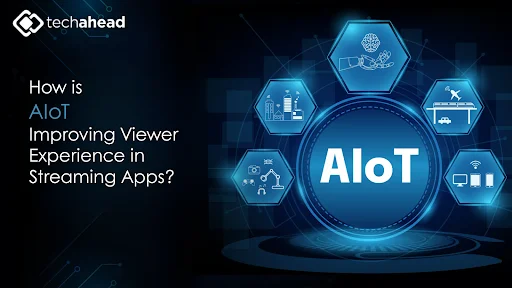The way people watch has changed. Big screens in the living room, phones on the train, tablets in bed. Streaming now sets the standard. Viewers expect fast starts, steady pictures, clear sound, and suggestions that actually fit their mood AIoT Improving Viewer.
However, the experience they receive depends on much more than simply a good, intuitive app interface. The mechanism of smart devices and intelligent software works smoothly behind the scenes to deliver content. The Artificial Intelligence of Things (AIoT) is key to interactive TV service, allowing control of video quality on the fly to ensure a smooth stream.
In this blog, we will explore how AIoT is changing the viewer experience inside streaming apps, and why it is becoming a foundation for next-generation platforms.
Dive into fresh perspectives and solutions—your next inspiration is a click away!
What AIoT Means For Streaming
AIoT links local signals from devices with models that can act on them in real time. In a single home you may find a smart TV, a casting stick, a mid-range phone, and a spotty Wi-Fi mesh. Each one sees a slightly different picture of what is going on. With AIoT, decisions can happen on the device instead of waiting for the cloud, which cuts delay and makes reactions feel instant.
Many platforms bring in the top AIoT development company to stitch this together. The job spans chips, operating systems, players, codecs, and data. Done well, the system keeps adjusting without the viewer lifting a finger.
Smoother Playback With Predictive Streaming
Buffering ruins mood. Traditional players wait for trouble, then drop resolution or pause. AIoT lets devices spot the trouble early. A TV that senses Wi-Fi instability can step down bitrate before a stall. A phone that sees a train entering a tunnel can quietly fill the buffer. In live events, this kind of early move keeps replays and key moments intact.
More Relevant Suggestions That Respect Context
Recommendations work best when they fit the moment. Long dramas on the couch at night. Short clips during lunch. AIoT reads context from the device itself. Screen size, battery level, network strength, time of day. The app can shift from “epic movie night” to “five-minute highlight” without the user hunting through menus. The result feels less like guesswork and more like good timing.
Voice And Gesture Control On The Device
Modern TVs and boxes can handle voice and simple gestures locally. That means quicker actions and fewer trips to the cloud. Say “pause,” swipe to skip, switch profiles with a quick prompt. Small gains add up, and they improve access for people who find remotes awkward.
Smarter Caching And Offline Viewing
AIoT can spot patterns and get content ready before it is needed. If a household watches a series every evening, the next episode can be prepared ahead of time. If someone commutes at 8 a.m., the app can line up a short playlist that works well offline. Less waiting, fewer surprises.
Health Checks That Prevent Crashes
Many “app problems” start with device health. Heat, low memory, or noisy background processes trip up playback. AIoT lets devices watch their own condition and take simple actions. Clear a cache. Nudge a restart after a show ends. Flag a setting that is causing trouble. Fewer support tickets, fewer one-star reviews.
Privacy, Rights, And Security Without Friction
Streaming involves accounts, purchases, and content rights. AIoT helps here too. Tokens can be checked locally. Basic fraud signals can run at the edge. Watermark choices can match device class without slowing the player. The boring parts stay boring, which is exactly what users want.
Where Experienced Build Partners Fit
Getting all of this into a real app is part engineering and part orchestration. Video players must work with HLS or DASH. DRM must cover Widevine, FairPlay, and PlayReady. UX must scale from a 6-inch screen to a 65-inch screen. Data must flow without tripping over privacy rules. This is where streaming app development services make a clear difference. The best results come from teams that treat devices as active participants rather than passive screens.
What It Adds Up To
Viewers judge an app in seconds. Did it start quickly? Did it stay smooth? Did it suggest something worth watching? AIoT helps on all three. It keeps video steady, lines content up with your situation, and eases the tiny pain points that add up.
Conclusion
AIoT is quietly changing how streaming platforms deliver content. Apps start quicker, quality adjusts in real time, and recommendations feel more relevant. Devices are no longer just endpoints. They gather signals, make decisions locally, and create a smooth viewing experience.
For companies growing a streaming service, this change opens real opportunities. Put strong engineering under clean design and you turn drop-ins into regulars. AIoT is more than future proofing, it delivers on today’s expectations with precision. Those who act early will lead the next wave of streaming, with confidence, clarity, and consistency.
Your next breakthrough is waiting—explore more and fuel your growth today!






